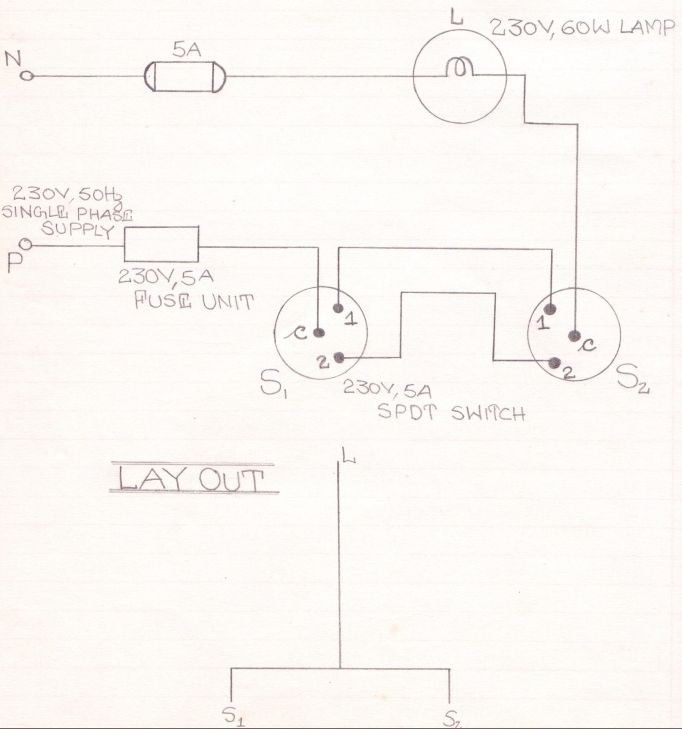Wiring Practice – Staircase wiring
A simple and practical way to set up staircase wiring is explained here. To operate a lamp from two different points by two switches at two different modes, connected with the help of staircase wiring.
List of Materials required
1) 230 V, 5A SPDT switches – 2
2) Switch box – 2
3) 230V, 60W Lamp – 1
4) Round block – 1
5) Holder – 1
6) L – Bend – 2
7) T – Bend – 2
8) 50 cm PVC pipes – 3
9) 10cm PVC pipes – 2
10) Clamps – 8
11) 1/4 inch screws – 16
12) 1/2 inch screws – 1
13)1/2 inch nails – 4
14) Wire – 5m
How to set it up
The lay out of staircase wiring is as shown in the schematic diagram above. The three 50cm PVC pipes are arranged in the form of an inverted T. The joint is provided by a T joint, say T1. At the left horizontal end of the pipe, another T joint (T2) is connected. Now, from the end of the joint T2 and the 50 cm pipe on the right side, connect two 10cn PVC pipes by means of L-Bends. The free ends of the 10cm PVC pipes are inserted into two switch boxes supplied. The vertical pipe is inserted to a round block which is fitted on the wooden slab. A bulb holder is fixed on the round block. Now, the two switch boxes fitted at the two horizontal ends and the holder which is fitted at the upper vertical end, thus form the layout of the staircase wiring. Wires are drawn through the pipes.
Now mark the corresponding poles on the two SPDT switches supplied as 1, C and 2. C refers to the centre pole. Poles 1-1, 2-2 are connected. The line wire is taken out of the T2 joint which is connected to the centre pole of the left switch. Another wire is taken out from the centre pole of the right switch which is connected to one of the poles on the holder. now another wire is taken out from the other pole of the holder as the neutral wire. Now, check for any shorting using a multimeter. If there is no short, wiring done is correct. Now, the switches are fitted on the switch boxes and clamps are fixed near the joints. A 230V, 60W lamp is put on the holder. The supply from the line is given.
What you will observe
S1 S2 Lamp
ON ON Bright
ON OFF OFF
OFF ON OFF
OFF OFF Bright
Precaution
One must be highly cautious while working in an electrical workshop. While giving connections to the supply, always connect to the neutral first and then to the phase. If the wire doesn’t have a plug and if we connected the wire first to the phase and then to the neutral, then there will be electrical shock if the neutral wire is in contact with the body. This is because that once the phase wire is connected, the whole circuit including the neutral wire will carry line current.
Other related articles you might be interested in reading –
Hospital Wiring – https://www.getallarticles.com/2013/10/26/how-to-do-hospital-wiring
Tunnel Wiring – https://www.getallarticles.com/2013/10/26/tunnel-wiring/
Godown Wiring – https://www.getallarticles.com/2013/10/24/hands-on-godown-wiring/
Fuse Provision – https://www.getallarticles.com/2013/10/24/fuse-is-provided-only-in-phase-and-never-on-nuetral-why

